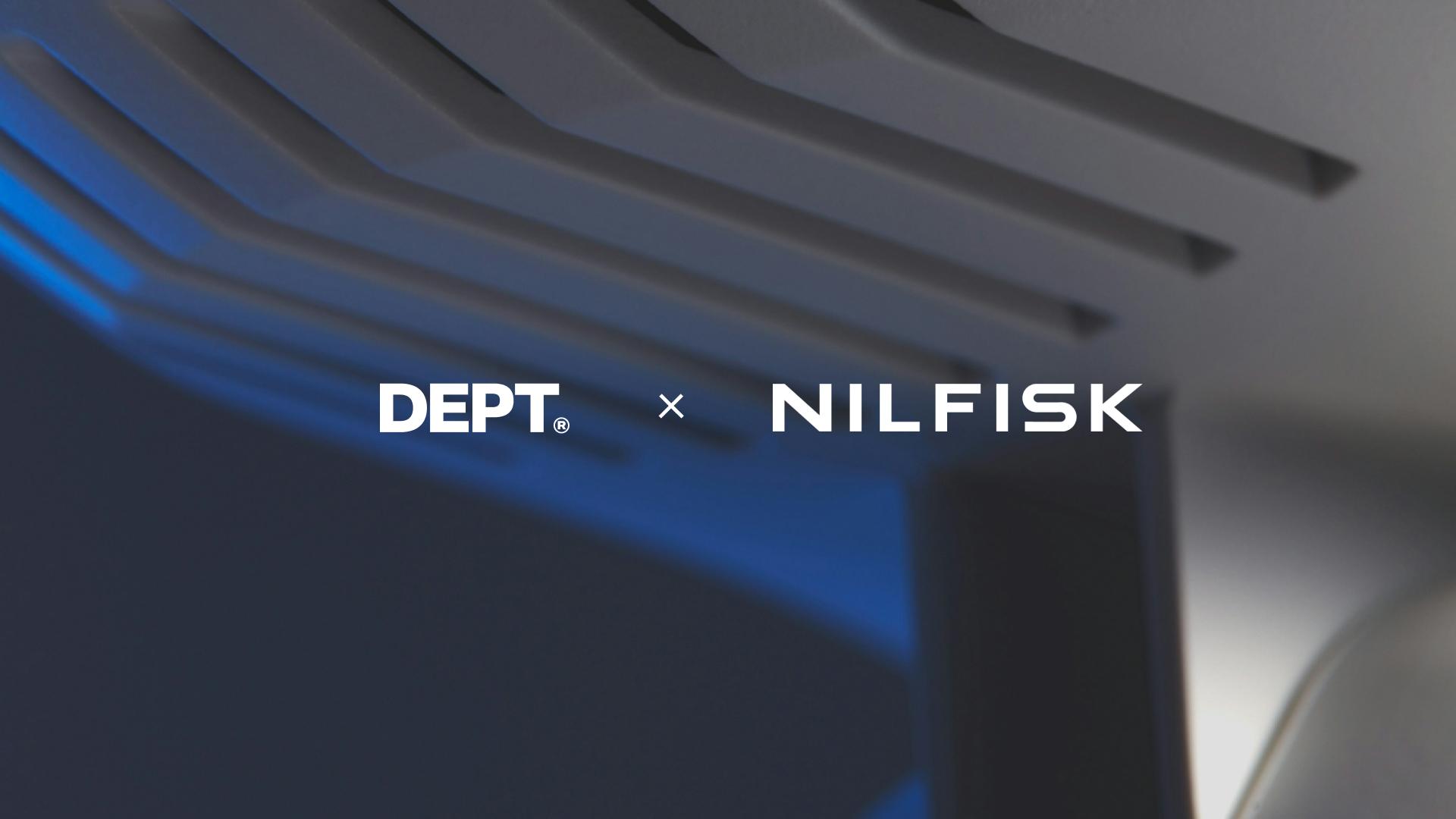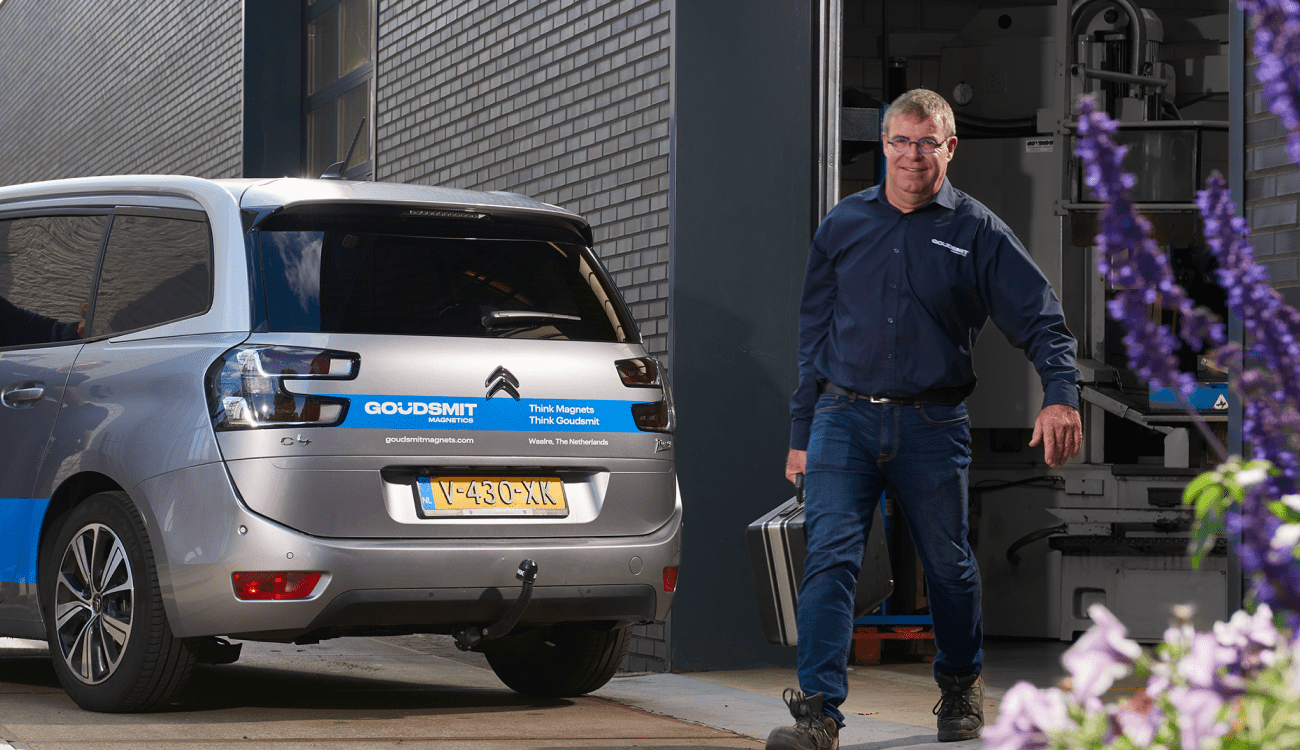When investigating the concept of a headless CMS and whether it would be a useful tool for an upcoming project, one may encounter various pros and cons. Generally, this doesn’t lead to more clarity when choosing a headless CMS or not. Luckily, you can simplify this process by aligning the advantages and drawbacks of a headless CMS and a comparing them with the classic CMS, making your life and final choice a whole lot easier.
What is a headless CMS?
Nothing to lose your head over, to be perfectly honest – yes, pun intended. When you boil a headless CMS down to its essentials, you will get a database with a simple and pretty user interface. It serves your data via an API to any client (website, mobile app etc.) that may depend on it.
Similar to database tables, a ‘content model’ is a core concept of any headless CMS, that when defined, gives structure to the data. Content model examples are concepts such as ‘Product’, Contact person details’, ‘Content page’ etc.
Content models contain fields that the end-user can fill in, producing a data object which is essentially your content. Data objects are an equivalent to a table row. Most self-respecting headless CMS systems will allow you to reference other data objects in order to form advanced structure and dependencies within the data itself. A foreign key if you will.
Now you may be asking yourself “If a headless CMS is nothing more than a database, what use do I have from it? What is the point? Why not simply have a database?”
Well, you could, but you would be missing out on some key advantages that a good headless CMS will provide you and your team.
What are the advantages of a headless CMS?
When working with a headless CMS, you will benefit from easier setup, simplified maintenance and will be working with a well-tested set of tools that make content creation and validation much simpler. A headless CMS will make your data available to any number of clients across platforms and programming languages, thus allowing you to create platforms instead of simple websites. To top it off, you will also have access to built-in support for data versioning, meaning that you can correct any mistakes without dealing with database backups.
- Timesaving tool: A headless CMS is yet another tool in the software engineers toolbelt. It will save you a lot of time when building a system either for yourself or your clients. Moreover, you save even more time if the system you are building is evolving and changing thereby requiring you to alter your data types.
The very fact that you can open the UI and create new and edit existing data types spares you a lot of effort. No need to mess around with SQL and database upgrade scripts. It is all handled by the CMS.
- Validation for properties: Contrarily to a regular database, with headless CMS, you’ll benefit by being able to define powerful validation properties. By defining the required fields as well as the string field format (email, phone, regex, etc.), managing data quality is effortless. Moreover, CMS provides you with the choice in how to display input to the end-user. The goal may be to display a list of strings as a single text box that produces ‘tags’ on every press of the ‘enter’ button. It could be multiple text boxes, one below the other for easy editing; limiting the scope of available dates on a calendar; the number of decimal points for a number; type of file you want to allow your end-users to upload; or the maximum dimensions of the image.
You get the point: a headless CMS will put all these tools at your disposal with only several clicks, leaving you to spend your time writing meaningful code.
- Data history and backup: Once your end-users start using the CMS, you may run into a situation where critical data is deleted or overwritten, and you need to get it back. A headless CMS will generally allow for a smooth data object audit. See who destroyed the data so they can get a slap on the wrists while you restore any lost values in just a few clicks. No need to fumble around with days old database backups that will restore your data to an ancient version only to restore one critical piece of information.
- Stability: An established, ‘battle-hardened’ headless CMS will generally be well tested, stable and bug-free. It will save you the stress of writing a custom UI for data input much like a classic CMS will.
- Cloud: Headless CMS lives in the magical internet place called the Cloud™… meaning that it is a server which is available to you and your end-users 24 hours a day/7 days a week. All the tools that you will need to access it and edit the data is a simple web browser. No specialised tools required for you or the end users.
Headless vs. classic CMS
So far, a headless CMS seems to have many advantages over a simple database, but what sets it apart from a classic CMS? Seeing how a classic CMS will usually be able to boast the same features, which of the two is better? Which one should you use? The answer depends on what you are trying to build.
If you’re building a website, a classic CMS is a perfect choice as it will allow your users to access it directly and preview any changes while editing the data. If you are dealing with a classic open-source CMS you will perhaps be able to alter it and install custom plugins to allow more functionality.
But what happens when you want to build a complex platform? Imagine a project where you need to build several websites and mobile apps for both Android and Apple ecosystems which in turn share the data with the website. Hypothetically, the system may involve additional services that run on Linux and Windows servers. And what if you want to support third-party developers?
In this over-exaggerated scenario, a classic CMS fails to deliver, given that you would need to write your own API around it to satisfy all those apps and services. You will need to manage caching, security and data consistency for example.
A headless CMS will provide these features to you ‘out of the box’ as the API is the primary way for you to interact with a client app, website or any other client. It allows you to specify security tokens that can only access a specific subset of data. By generating unique security tokens for each data consumer, you can create a safe way for any client apps to read and write the data that they have access to. Multiplatform compatibility is not a concern since you will generally be dealing with JSON, which every modern programming language can process.
Webhooks
Another powerful feature of a headless CMS is to define and fire off webhooks. They are simple event-driven systems that send HTTP requests that you define to any URL of your choosing. For example, this allows you to notify all your websites that a product description in the CMS has changed and they should clear their cache and retrieve a fresh copy of the data.
What are the downsides and ‘gotchas’ of a headless CMS?
While boasting many advantages, a headless CMS is not perfect. It will put some obstacles in your way and make certain scenarios complicated to deal with. Difficulty in testing new features without affecting live environments, offline work for your client systems and the fact that your data exists on a server which you do not control are just some of them.
- Testing difficulties: For example, testing your code for various environments (test, integration, production) may not be as straightforward on a headless CMS because many of them do not support this feature. More often than not you will be dealing with a single environment and one set of data, which causes issues when developing new features or changing existing ones in a way that forces you to adapt the data models.
Ideally one would do so on an isolated environment so as not to affect the existing data. Some headless CMS products on the market may include rudimentary tools for duplicating your data and allowing you to access it separately from the original which solves half the problems related to this drawback. However, when making changes to content models or the data itself and the time comes to release the new feature, developers often face problems in propagating those changes back to the original environment without damaging it or causing data corruption. You should expect a lot of manual data model adjustments in many headless CMS products you can find on the market right now.
- Always online problems: Despite the benefits of a constant online presence, it can be a problem when your client software loses access to the internet. Unless you put in a lot of effort to cache your data and properly synchronize any changes with the headless CMS it may cause you a lot of headaches when the various mobile apps, services, and applications come online and start injecting old data into the existing system. You may get messed up Ids, duplicate data, out of order data, etc.
- Data behind a paywall: In case you get a paid product, you will be required to shell out a monthly subscription. If you don’t pay your subscription, your data may no longer be made available to you. It’s as simple as that. You may be spared of this downside when using a free product, but, free products often have a stigma of being of lower quality due to low incentives for developers to maintain and update them.
In most cases, you will probably be able to retrieve your data via support staff, but, unless you pay your subscription, the API access is going to be blocked, thus rendering your clients completely cut off from the data.
‘Too long, didn’t read’ summary
A headless CMS is an advanced database with a pretty user interface. One should view it as a tool that will save you a lot of time and effort because it will usually come with powerful features for validating data, ensuring its safety and versioning. It will generally be stable and well tested. Another major benefit is that your data will be available to you via an API 24 hours a day/7 days a week. A headless CMS’s most important feature is that it bridges the gap between platforms and programming languages as it will generally serve your data in the form of XML or JSON.
A common problem that come with using a headless CMS is the lack of support for data separation for multiple environments (test, acceptation, integration, production, etc.). It will often be quite a bit of work to alter production without a lot of careful, manual editing of content types. Being always online is good when it works as intended, but in case your clients lose connection to the headless CMS API, you may run into issues with data synchronization. Finally, if you use a licenced headless CMS your data will be trapped behind a paywall.
More Insights?
View all InsightsQuestions?
Monolithic architecture is a thing of the past; we’re now in a headless future. Headless technology is quickly becoming the first choice for many organisations seeking to architect an agile and flexible technology stack. From commerce to content management, headless tech is enabling IT and Marketing teams to deliver the digital experiences their business needs and their customers want, across multiple channels, quickly and easily.
Headless – the basics
The term “headless” comes from the analogy of cutting the ‘head’ (which is the front-end in this scenario), from the ‘body’ (the back-end). Essentially, headless systems view the front-end and back-end as separate systems and focus on the back-end only. This means you can change one aspect without affecting the other; developers can create new websites or applications without being tied to any specific framework or language. A headless architecture can enable flexibility, reusability, and connect various data sources to support your business in the creation of new digital experiences.
Best of need vs. best of breed
There are numerous headless technologies available on the market, from Commerce to Content Management Systems and Digital Asset Management. When deciding what kind of headless systems your company needs, there are two main options to choose from:
- Best-of-Need: is a suite of products which are pre-integrated and have a common user interface. It’s a generalist more than a specialist approach; each product in the suite isn’t the best in its class, but usually fulfills the basic needs most organisations have.
- Best-of-Breed: these are often niche systems which perform specialised functions better than an integrated system, often with the ability to quickly add or swap components which you think are necessary. One of the main downsides of these products is that they are frequently from different vendors and, as such, need to be integrated with other existing systems.
The advantages of headless
Headless systems have numerous advantages, from lower operating costs to an easy setup.
- Flexibility: multiple teams can interact with the system at the same time. Meaning your digital teams can each work on their tasks which are then connected via APIs. This gives each team full flexibility and can rapidly increase time-to-market.
- Faster time-to-market: headless systems promote an agile way of working. Each team can work simultaneously on its tasks using one system without getting in each other’s way. Also, businesses can more easily and efficiently replace or upgrade various aspects of their existing infrastructure. This means the production process can be sped up and your website can undergo maintenance while still being online.
- Stability: an established headless system will generally be well tested, stable, and bug-free. It will save you the stress of writing a custom user interface for data input.
The risk of using headless
Of course, like all systems, headless approaches also have a few downsides that companies should be aware of:
- Forgetting about the editors: most companies spend a lot of time thinking about their customers and how to create experiences that they will value. However, let’s not forget about the people who have to create these experiences. They have to be able to easily use and enjoy whatever system your company puts in place to ensure maximum usage of said tool. Before choosing a headless system, brands need to understand how their teams work and what functionality they need to make them as effective as possible.
- Aggregation and scalability: if you start to have many “heads” and many “bodies” it can be hard to track the dependencies each one relies upon, making it difficult to mix and match each component. Additionally, if a website needs to talk to five different APIs to provide the content and functionality required, it can start to have scalability issues. By aggregating the APIs into a management solution, these issues can be alleviated and also provide additional caching and scalability options.
- System silos: Multiple different systems can mean that teams are not working together and data is not being shared. Organisations need to ensure that new business software can be easily integrated with others. This is something which is more likely to happen with best-of-breed approaches compared to best-of-need.
Accelerate with headless systems
Flexibility and rapid time to market are critical for today’s challenges – long development cycles, upgrades and deployment times typical of monolithic platforms can no longer be tolerated.
Moving to a Headless approach for our technology platforms is increasingly the answer to accelerate and enable our IT and marketing teams to deliver the digital experiences their businesses need and their customers want, across multiple channels, quickly and easily.
More Insights?
View all InsightsQuestions?
Global SVP Technology & Engineering
Jonathan Whiteside
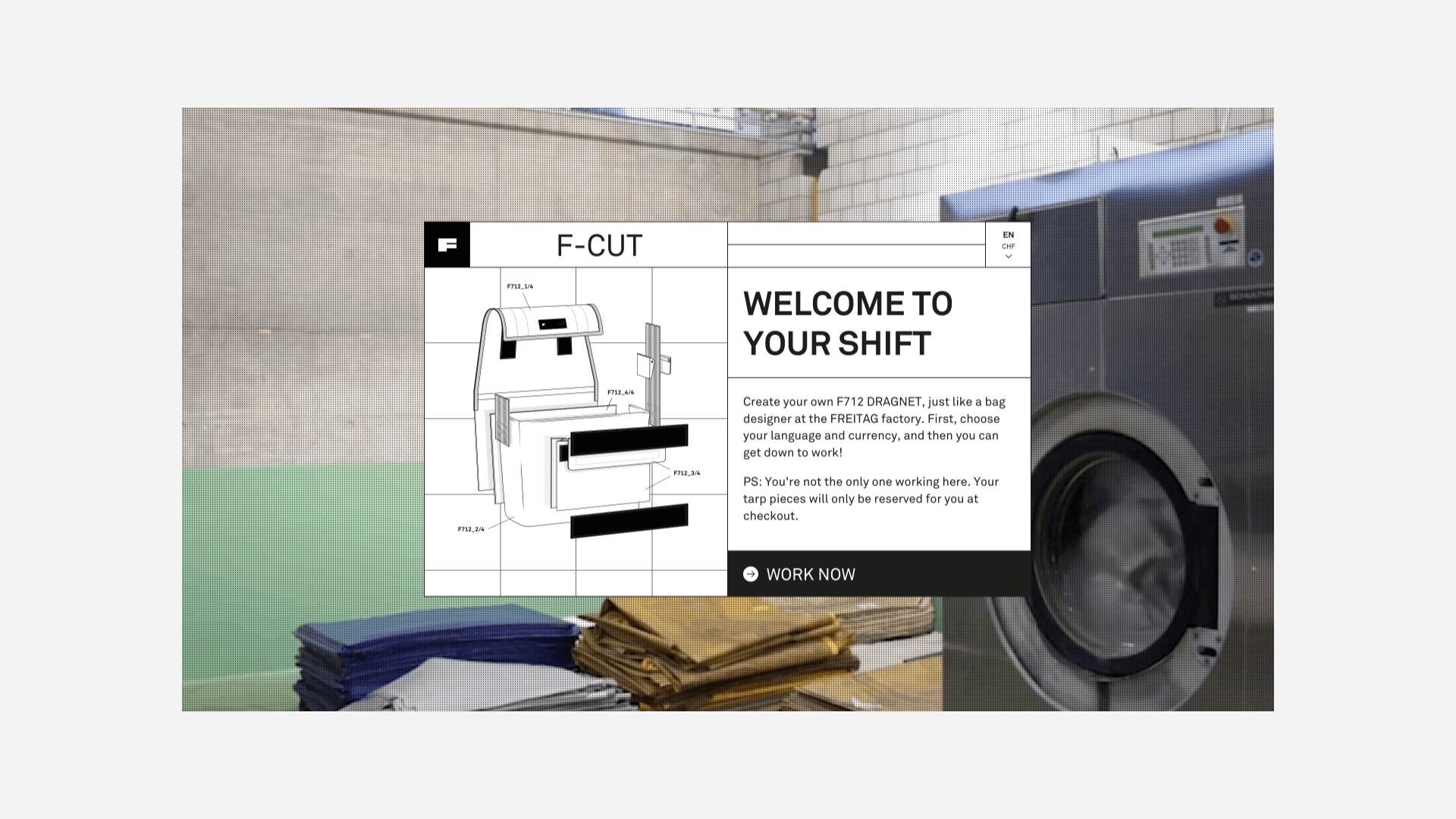
The sustainable Swiss brand FREITAG, known for their bags and accessories made from used truck tarpaulins, has always stood for individualism. With the new digital tool F-Cut, FREITAG now offers its customers the opportunity to design their very own super unique items. The idea behind it was born 20 years ago – and comes from a DEPT® employee.
Desire for more uniqueness
Each of the approximately 300,000 FREITAG bags and accessories produced each year is unique. A large proportion is manufactured in Zurich, where the truck tarpaulins are dismantled and washed by FREITAG employees before the bag designers cut out the best motifs with their cutter knives and templates and these are then processed into bags.
So far, so good. But more and more often, customers inquire in the FREITAG stores whether a specific bag is also available in another color, with this or that motif. The bag makers have taken these requests for (even) more uniqueness to heart – and fell back on the diploma thesis in which DEPT® employee Severin Klaus invented, designed and programmed the first F-Cut for FREITAG 20 years ago.
Democratisation of bag design
The DEPT® team in Switzerland has been working with FREITAG since 2020 and has, among other things, implemented a bag swapping campaign on Tinder for the brand. Now FREITAG approached us to awaken the online cutting table F-Cut from its slumber together with bag and UX designers, logisticians and many other experts.
The following positioning and visions were defined in a preliminary project:
Democratisation of bag design
Every interested customer should have the opportunity to design their own unique bag according to their own taste, beyond all design guidelines.
Bringing FREITAG’s values to life
Sustainability and individualism come first. The FREITAG Sweat-Yourself-Shops are to be transported from the physical to the digital world by means of F-Cut.
Revival of a classic
The new F-Cut is to be as good as the multiple award-winning 20-year-old original, but even more user-friendly and contemporary.
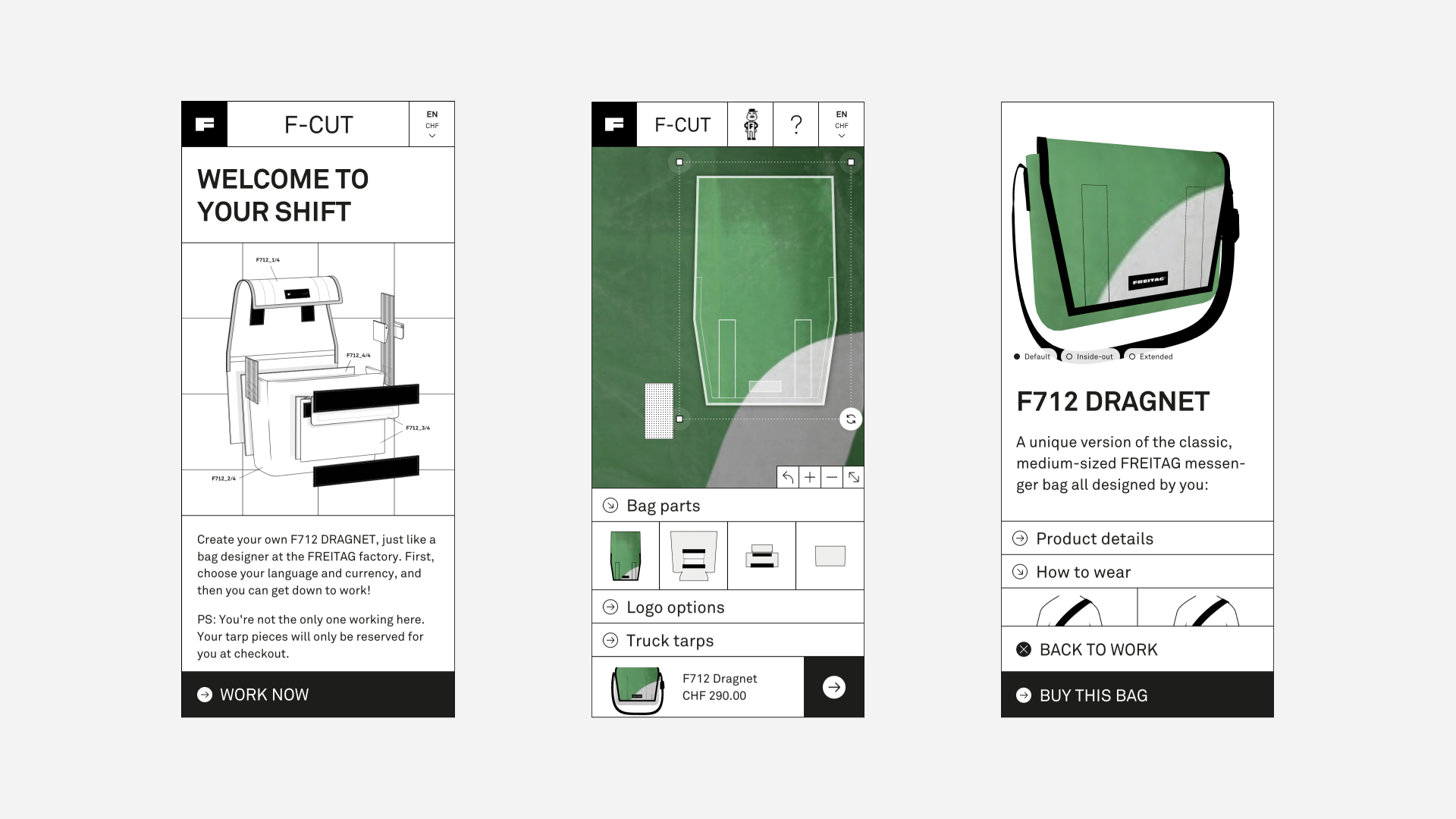
Linking the offline world with the online world
F-Cut offers a unique combination of rough & real materials with digital perfection and a smooth product configuration – no matter on which device, including 3D preview in real time. In this way, the offline world of FREITAG is linked to the online world thanks to a unique experience.
For F-Cut, DEPT® not only implemented the UX, UI and the 3D preview, but also the back- and frontend. The visual identity, creative direction and copy were done by FREITAG.
From a technical perspective, F-Cut is a web application that combines various systems. On the one hand, there is of course the F-Cut app – the GUI – in which FREITAG customers configure their bags. Then there is the F-Cut backend with a headless CMS, which primarily provides a database and communicates via API with the checkout (FREITAG online store) and of course the F-Cut app. In addition, there are further admin interfaces with everyday tarpaulin management functions (configuration, orders, etc.) and tarpaulin upload, editor and export (DXF) for production.
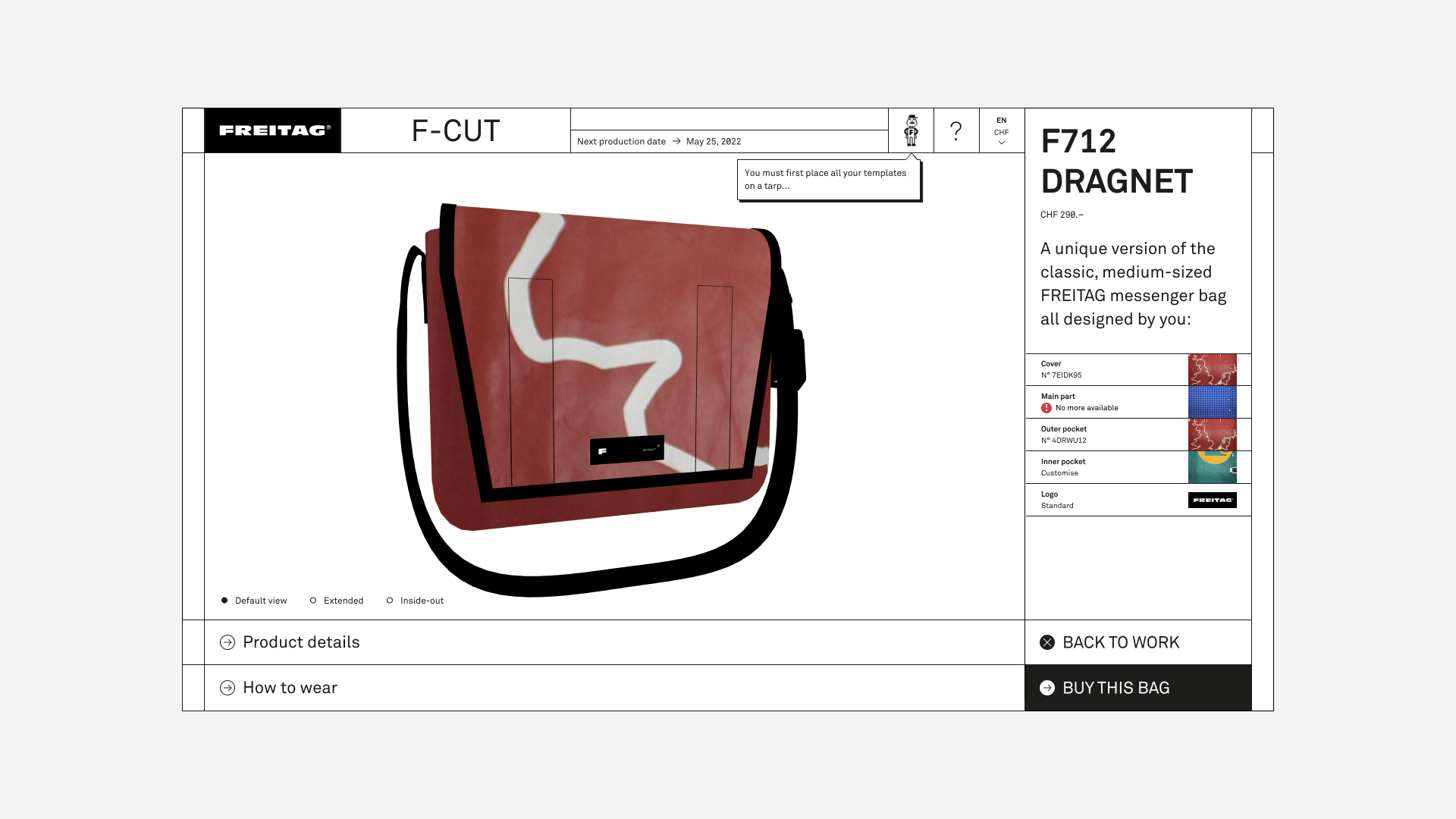
Bag dreams come true
For the first release, the focus was on the KISS principle (Keep It Simple, Stupid): we limited ourselves to one bag type, the Messenger Bag F712 DRAGNET, which can be designed using four virtual templates from a selection of 20-50 different truck tarps. The designable bag types could be expanded in the future or the bag type could change at fixed intervals.
In order to ensure fairness and equality, new tarpaulins are silently added to the system to exclude disputes about the “good” tarpaulin pieces. Another important aspect for FREITAG was the balance between maximum design freedom and sustainability: leftover tarpaulins are used for accessory products.

A few numbers
The response to the F-Cut has been overwhelming, especially from Japan, Germany and FREITAG’s home market Switzerland.
- The virtual cutting table is very busy – between 40-60 users at a time are designing their own F712 DRAGNET Messenger Bag online every day.
- Since the launch in May 2022, more than 300 digitised truck tarpaulins have been used.
- In addition, FREITAG also received many requests from their fans to introduce F-Cut for other bag models as well.
What’s next?
Already before the go-live, F-Cut triggered enthusiasm both among the DEPT® and FREITAG teams. Several further development projects are already planned: more products and features are to follow. 20 years after the birth of the idea, F-Cut has finally awoken from its slumber and will continue to grow steadily.
Over 20 years ago, I got to implement F-Cut as a student one-man show – to rethink this project now, with the support of a fantastic team, both on the DEPT® side and on the customer side, while exploiting the possibilities of today’s technology, is a great privilege.
Severin Klaus, Tech Director, DEPT®
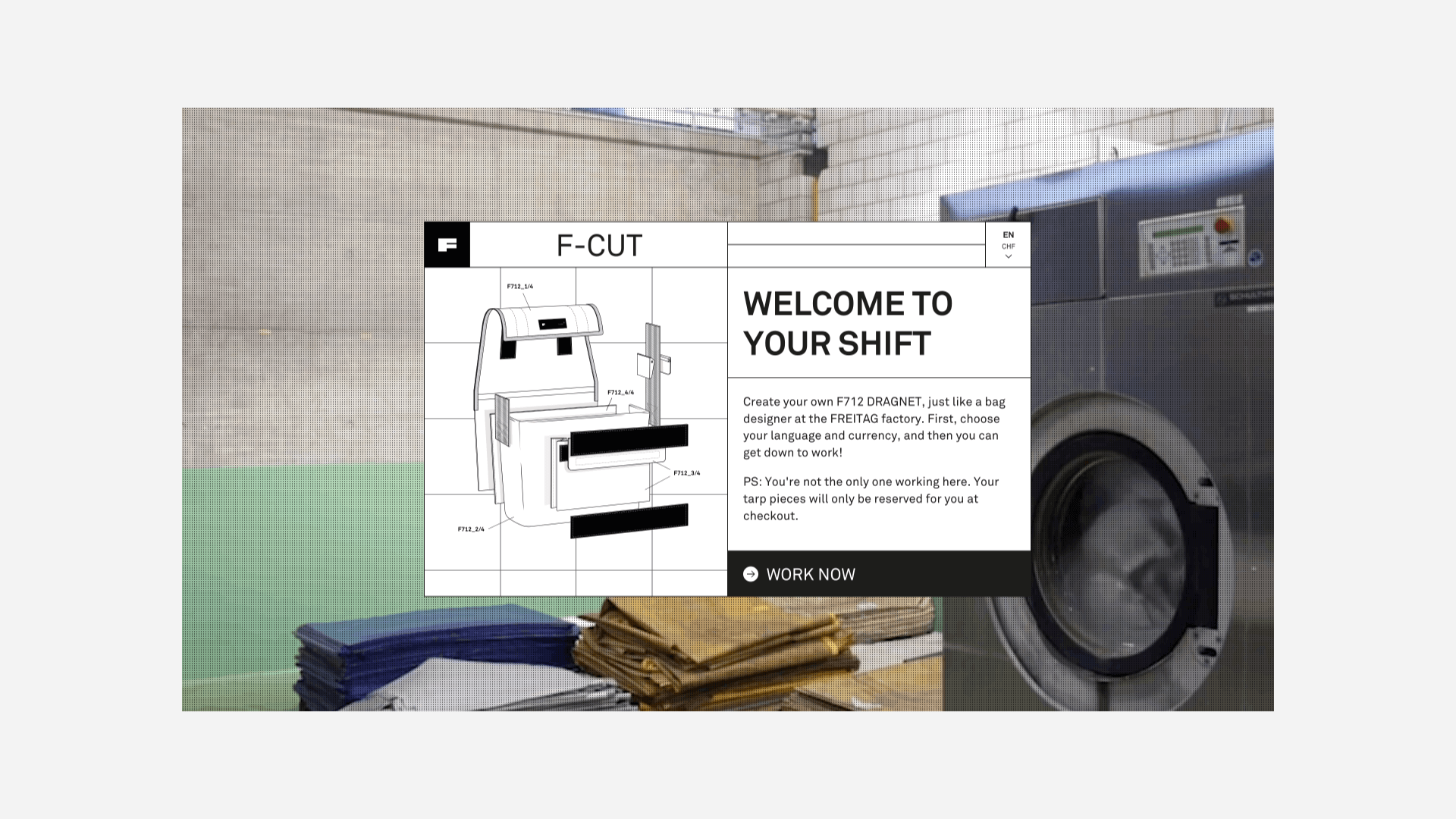
The sustainable Swiss brand FREITAG, known for their bags and accessories made from used truck tarpaulins, has always stood for individualism. With the new digital tool F-Cut, FREITAG now offers its customers the opportunity to design their very own super unique items. The idea behind it was born 20 years ago – and comes from a DEPT® employee.
Desire for more uniqueness
Each of the approximately 300,000 FREITAG bags and accessories produced each year is unique. A large proportion is manufactured in Zurich, where the truck tarpaulins are dismantled and washed by FREITAG employees before the bag designers cut out the best motifs with their cutter knives and templates and these are then processed into bags.
So far, so good. But more and more often, customers inquire in the FREITAG stores whether a specific bag is also available in another color, with this or that motif. The bag makers have taken these requests for (even) more uniqueness to heart – and fell back on the diploma thesis in which DEPT® employee Severin Klaus invented, designed and programmed the first F-Cut for FREITAG 20 years ago.
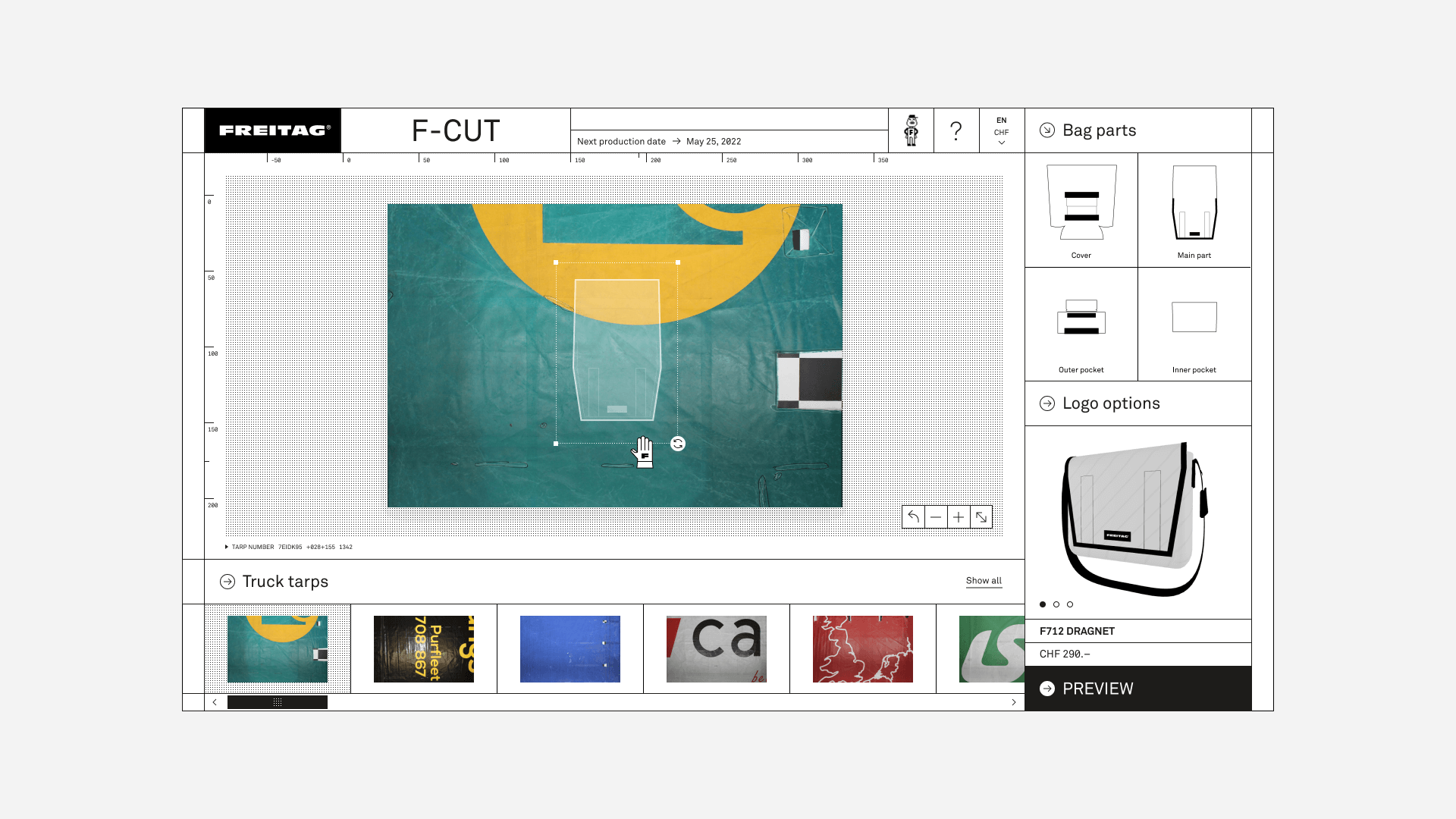
Democratisation of bag design
The DEPT® team in Switzerland has been working with FREITAG since 2020 and has, among other things, implemented a bag swapping campaign on Tinder for the brand. Now FREITAG approached us to awaken the online cutting table F-Cut from its slumber together with bag and UX designers, logisticians and many other experts.
The following positioning and visions were defined in a preliminary project:
Democratisation of bag design
Every interested customer should have the opportunity to design their own unique bag according to their own taste, beyond all design guidelines.
Bringing FREITAG’s values to life
Sustainability and individualism come first. The FREITAG Sweat-Yourself-Shops are to be transported from the physical to the digital world by means of F-Cut.
Revival of a classic
The new F-Cut is to be as good as the multiple award-winning 20-year-old original, but even more user-friendly and contemporary.
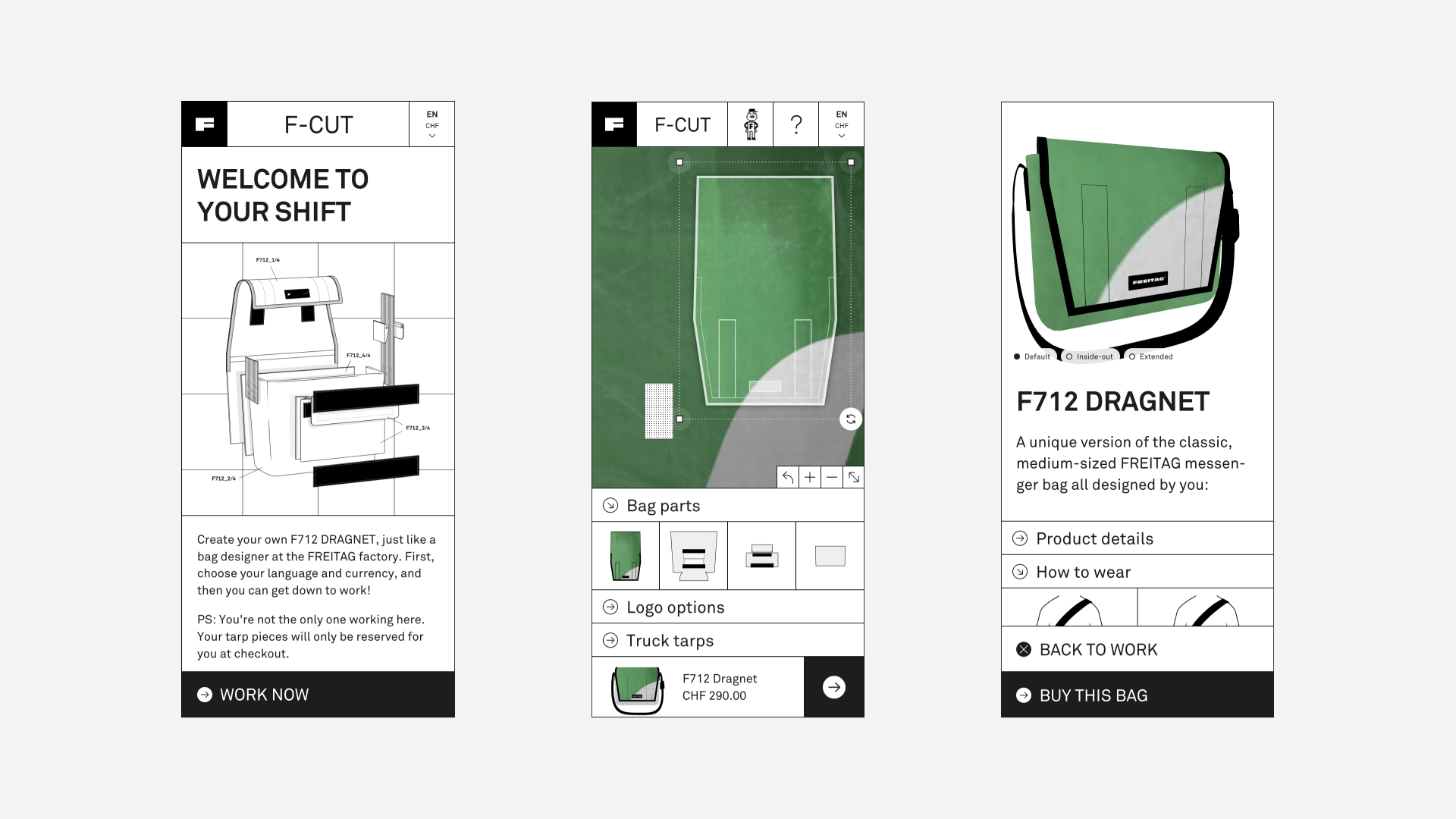
Linking the offline world with the online world
F-Cut offers a unique combination of rough & real materials with digital perfection and a smooth product configuration – no matter on which device, including 3D preview in real time. In this way, the offline world of FREITAG is linked to the online world thanks to a unique experience.
For F-Cut, DEPT® not only implemented the UX, UI and the 3D preview, but also the back- and frontend. The visual identity and the texts were created by FREITAG.
From a technical perspective, F-Cut is a web application that combines various systems. On the one hand, there is of course the F-Cut app – the GUI – in which FREITAG customers configure their bags. Then there is the F-Cut backend with a headless CMS, which primarily provides a database and communicates via API with the checkout (FREITAG online store) and of course the F-Cut app. In addition, there are further admin interfaces with everyday tarpaulin management functions (configuration, orders, etc.) and tarpaulin upload, editor and export (DXF) for production.
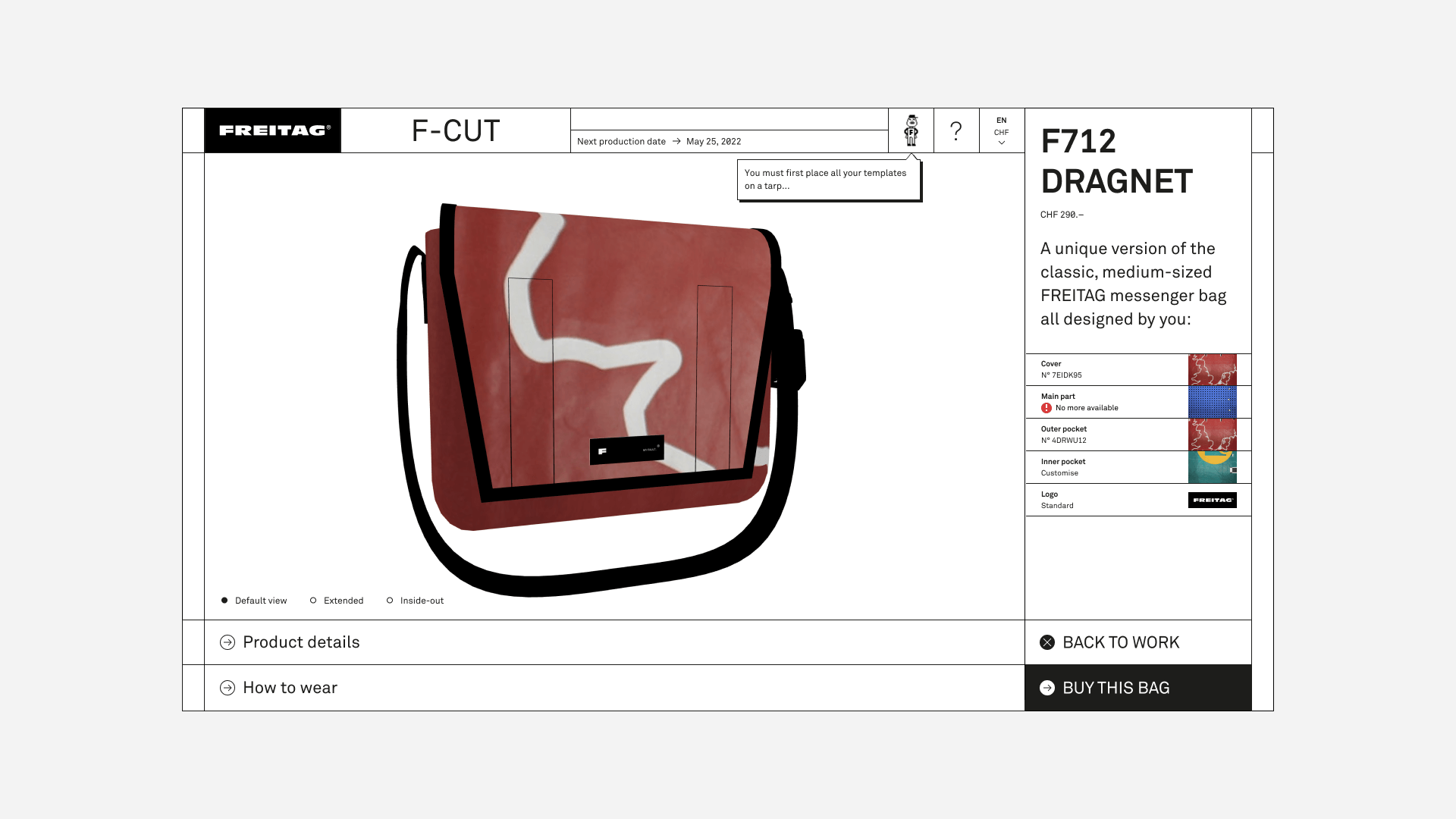
Bag dreams come true
For the first release, the focus was on the KISS principle (Keep It Simple, Stupid): we limited ourselves to one bag type, the Messenger Bag F712 DRAGNET, which can be designed using four virtual templates from a selection of 20-50 different truck tarps. The designable bag types could be expanded in the future or the bag type could change at fixed intervals.
In order to ensure fairness and equality, new tarpaulins are silently added to the system to exclude disputes about the “good” tarpaulin pieces. Another important aspect for FREITAG was the balance between maximum design freedom and sustainability: leftover tarpaulins are used for accessory products.

What’s next?
Already before the go-live, F-Cut triggered enthusiasm both among the DEPT® and FREITAG teams. Several further development projects are already planned: more products and features are to follow. 20 years after the birth of the idea, F-Cut has finally awoken from its slumber and will continue to grow steadily.
Over 20 years ago, I got to implement F-Cut as a student one-man show – to rethink this project now, with the support of a fantastic team, both on the DEPT® side and on the customer side, while exploiting the possibilities of today’s technology, is a great privilege.
Severin Klaus, Tech Director, DEPT®
Questions?
Head of Consulting & Project Management
Vera Weber
Discover more
commercetools is a headless e-commerce platform which provides the building blocks for the new, digital commerce age.

A flexible, headless commerce platform
commercetools allows brands to build and enrich their online shopping experience. In order to do so, they provide the speed and flexibility that today’s digital world demands with the use of microservices and APIs. As a commercetools partner, DEPT® is equipped to help companies implement and use this software.
commercetools is a pioneer in the field of microservices. These include all e-commerce functionalities, such as PIM, cart and order management, marketing and promotions, payments and internationalisation. A flexible and fast API connects these services to all relevant front-ends and applications such as webshops, mobile apps, voice, AR/VR applications and social networks. We have implemented this rock-solid e-commerce platform for clients including Eurail, Goudsmit Magnetics and Holland & Barrett.
commercetools operates according to the modern MACH principle: Microservices-based, API-first, Cloud-native and Headless.
Functionality
Microservices
commercetools’ functionalities are developed in a modular way in which each function can be used and developed separately.
API-first principle
More than 300 APIs unlock all kinds of functionalities one could desire. DEPT®-partners Contentful, Bloomreach and Magnolia provide default integrations for commercetools. Due to the ‘API First’ principle, commercetools works efficiently with any front-end solution.
Cloud-Native
commercetools runs entirely in the cloud, guaranteeing IT performance, scalability and security.
Headless
The focus of commercetools is on creating functional commerce building blocks for your webshop.
Compatible with ADA/DASH
commercetools is now integrated with ADA/DASH, our headless e-commerce accelerator that provides the building blocks for modern e-commerce sites. A composable approach impacts both the implementation of the front-end and influences the end-to-end process and methodology, from design through to deployment.
commercetools integrates with DASH and allows for faster development and deployment of your e-commerce store; less time is wasted on duplicative tasks and more time spent creating an exceptional experience.
The out-of-the-box design and development elements provided by DASH include the scaffolding, DevOps and infrastructure, localisation, CMS integration, product search integration, automated testing, performance and accessibility testing, documentation, and monitoring.
ADA/DASH can deliver headless e-commerce sites months faster than traditional development.
Our Clients










We value a great working relationship with our clients above all else. It’s why many of them have worked with us for years as their trusted partner.
Talk to us about commercetools
Principal Digital Consultant, Design & Technology
Katy White
Insights
BloomReach
DEPT® is a BloomReach implementation partner working with the BloomReach Digital Experience (DX) platform (Hippo).
An open & intelligent platform
We help enterprises accelerate their business with an agile, Java-based CMS solution and an open and intelligent DX platform.
Our certified developers can work with global companies with diverse digital requirements to migrate to a DX platform that integrates quickly into their current architecture. Taking full advantage of the BloomReach Hippo DX cloud architecture, open APIs, multilingual support, personalisation capabilities, A/B testing, and trend analytics, we can help businesses to control, measure, and optimise the enterprise digital experience across all digital channels and global touchpoints.
BloomReach’s DXP leverages a “headless CMS” approach”, which separates the content and presentation layer to allow you to reuse content and services across multiple environments more easily. Based on the insights Bloomreach-Hippo gives you about the content performance, you are able to create and optimise personalised multilingual content which matches your audience expectations.
DEPT®’s expertise in experience design, extensible architecture, and technology integration can develop a BloomReach Hippo DX solution that gives your businesses the power to deliver personalised content for every visitor, in any context and on any device.
Talk to us about Bloomreach
Strategy Director
Danijel Bonacic
The process of building an e-commerce platform can seem like new ground to many B2B CEOs. Understanding the array of software options on the market, learning new phrases like ‘headless commerce’, being able to distinguish between a CMS and a DXP. These surface-level barriers can scare some away, but by digging a little deeper, every company head will find themselves in familiar territory.
A successful B2B commerce platform is built on an in-depth understanding of the customer. Awareness of customer needs. Knowing what causes friction in the purchasing process and how to work around it. The leadership team are experts in their industry and know what makes their customer base tick. By stripping away the excessive acronyms and complicated definitions, B2B commerce comes down to knowing what customers need.
At its very core, digital transformation is about making your company’s assets go further. Can the innovative thinking of the leadership team be implemented quicker? Can insights gathered from customer data be applied to other areas of the business? Can consumers be given an easier path to purchase? Digital transformation magnifies strengths by focusing on scalable improvements.
Brenntag: building a digital chemical business
For Brenntag, a German chemical distributor operating in 76 countries, implementing a digital transformation began with an appreciation of their industry. Brenntag’s world, the chemical sector, is heavily physical. However, digital transformation touches on each aspect of the business. At every turn, innovative digital approaches could be used to optimise and improve the efficiency of internal processes and ease the experience of customers.
The process of digital transformation was split along internal and external improvements that could be made. Working with DEPT®, the company put together a system of Internal Tooling that set out to improve the efficiency of their every day, internal processes. This includes features like Brenntag Source, an application for reviewing supply chain data.
Use existing supply chain data to help your clients
The Brenntag Source feature can be used to filter data on different suppliers, giving Brenntag the information they need to engage in informed face-to-face negotiations with suppliers.
For the customer, this information can be turned into tracking software, keeping the buyer updated about the delivery of their purchase, and also informed about the sourcing, materials and manufacturing of their order. Good customer experience is what drives repeat purchasing, particularly in the manufacturing sector where trust is a key business driver. This added value can be what sets the company apart from its competition, as it puts the customer at the centre of the process, answering every question they may have.
On the external side, Brenntag Connect was created, an e-commerce portal that provides customers with information on the chemicals and orders that Brenntag provides, as well as a platform to track their security data, invoices and orders.
Make repeat purchasing a top priority
When planning a B2B commerce platform, it is important to think of the sector-specific rules that affect how it can be used. Due to the regulated nature of the chemical industry, Brenntag Connect is only available for customers that have gone through an intensive onboarding process. This means that users of the platform are likely to be committed, long term customers, therefore making repeat purchasing easy was a top priority. To this end, Brenntag implemented an automated repeat business function.
One of the key challenges for any commerce platform project is to establish a long term strategy. To start putting a system like this in place, put together a list of needs that the platform must fulfil. From this information, build a digital roadmap that outlines the steps your business will take over the next three years, each time responding to a customer need.
Digital transformation is a step-by-step journey, not an overnight makeover. By beginning with priority areas based on customer needs, your company can start serving customers better and begin the process of learning and adapting your e-commerce approach.
Like any map, the route is liable to change based on real-time information. Data capture is a core need for any project, informing and ensuring that the decisions and actions taken are correct. What we measure, we can affect. In terms of a digital roadmap, see the data as you would see live traffic updates. Be ready to get past roadblocks by adapting the route.
To keep their digital transformation on track and ensure, Brenntag built DigiB, a digital innovation hub that operates autonomously from Brenntag. The organisation aims to rapidly accelerate their technological innovation across the business, running small scale projects that have the potential to scale, and aiding the implementation as Brenntag finds new, more efficient ways of operating.
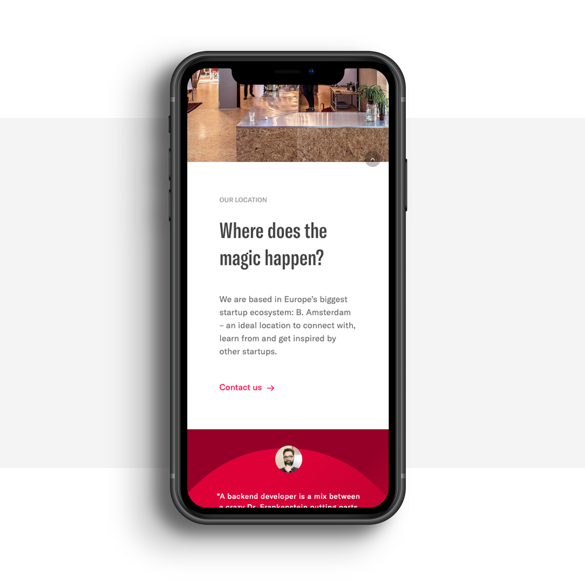
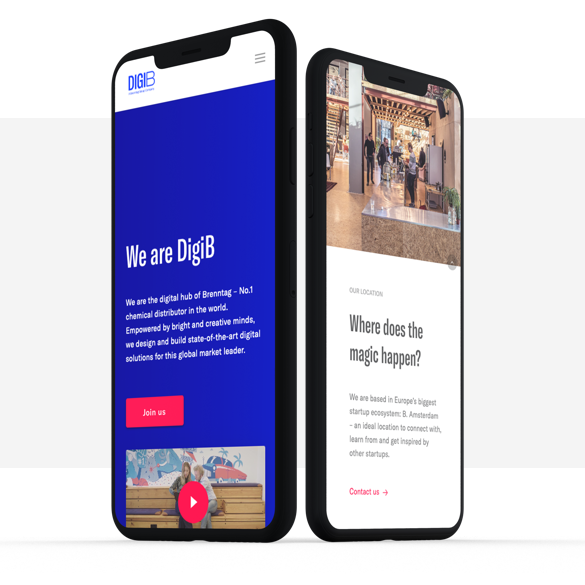
The guiding motto of DigiB is “create it, launch it, learn from it.” Rather than taking the time to perfect every single release, adding months to the lead time, DigiB focuses on putting new projects into the marketplace. Release a smaller scale project. If it works, scale it up, if it doesn’t, take a step back and learn from the problems that users experienced. This way, every project is a worthwhile endeavour, creating a ‘succeed or learn’ mentality that fosters a strong corporate mentality.
Being able to create a company-wide culture that believes in the digital transformation project matters, as each department is able to offer input on how the key business goals can be achieved. Sales teams will be speaking to current and potential customers day in, day out. Operational teams will be using the internal tools each day, able to give feedback on what works and what is still missing.
Each business will have a different priority when it comes to building a B2B e-commerce platform. This depends on the customer needs in each sector and any pressures that are placed on the business by industry regulations. The list below looks at some of the most common priorities, though each business is different.
Making product discovery clear and simple
Companies with a wide array of available products or services will benefit from making sure that the site is built to provide easy-to-understand information on each product. On each product page, aim to answer any question the customer could have; keeping the customer on the product page means more proximity to the checkout.
Easy product discovery also means clear categorisation of products. Many B2B suppliers and distributors provide highly specialised products; it is the company’s responsibility to make finding the appropriate specialised product simple. The less friction in the buyer’s journey, the more likely they are to purchase.
Enabling site search
An undervalued benefit of building an e-commerce platform, site search is an obvious boost to user experience, but also an important data gathering tool. For many visitors, site search is how they engage with the site. It’s the bridge between each page, expediting the process of finding a product to buy. In terms of user experience, various features can be implemented to aid their search, such as autofill, search correction suggestions, and the ability to filter results. For visitors that are used to the features offered by Google, these additions to site search are less an added bonus and more of an expectation.
With site search implemented, make sure to review the analytics software to follow the journeys that users take around the site. Each business spends a good chunk of time trying to understand buyer journeys; this feature gives users the ability to track each journey to purchase.
By putting an advanced search tool in place, your business is able to see the key information that customers gravitate towards. It also Indicates missing content that the business should create – the questions customers are asking but not finding the answer to. The business can also see which additional purchases are considered, but not added to the basket, showing potential sales activations to use. Working with Omron, DEPT® used site search analytics and the onsite tracking software Hotjar to see how the architecture of the site was impeding users from checking out.
Putting all this together, the information can be used to provide a much more personalised experience for each visitor. Personalising the shopping experience boosts e-commerce sales, in DEPT®’s ‘What Do Consumers Really Think Of Personalisation?’ study, we found that 38% of consumers would spend more if a brand uses personalisation relevant to their needs. For Omron, this resulted in a tailored experience based on whether the visitor self-identified as a distributor, a system integrator, an employee, an end-user, or a member of the press. Giving the appropriate information led to a 20% fall in bounce rate and a doubling of the average number of pages visited per session.
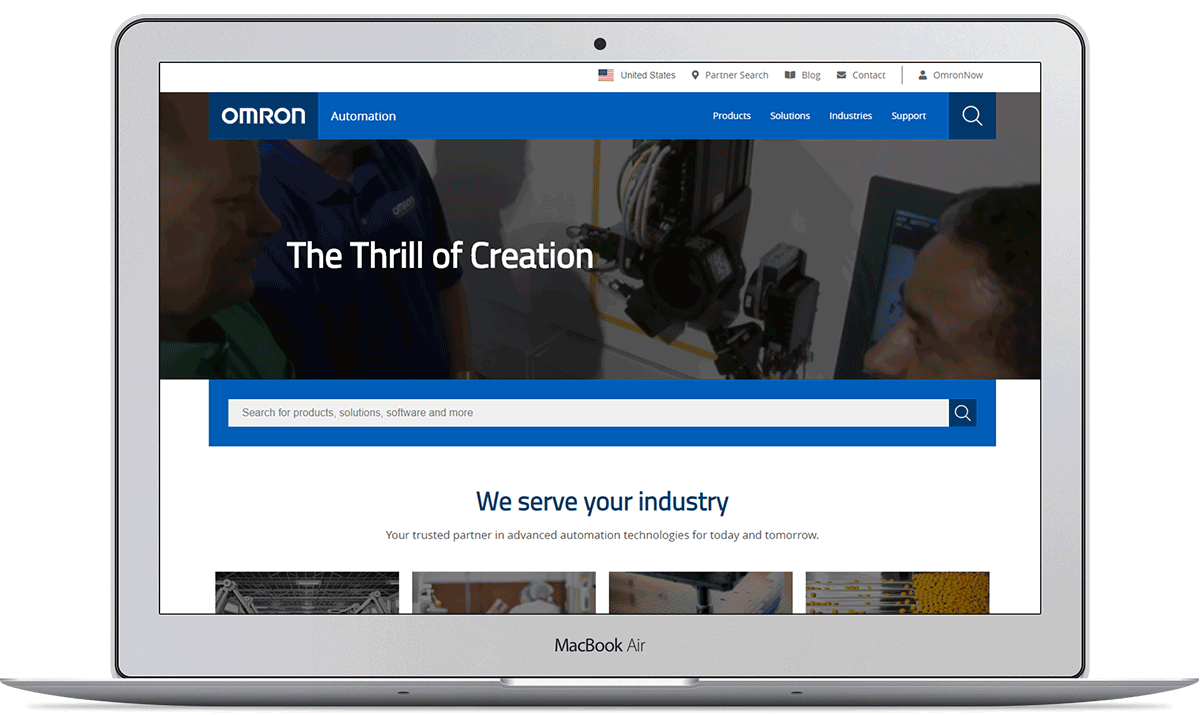
Logistics, lead time and availability
For a B2B commerce platform, providing detailed information on the manufacturing, shipping and delivery time is a key addition. Availability too, as nothing is more frustrating than finding the right product only to see it’s unavailable. This information is vital to future planning. It helps the customer plan their purchases and ensures they fit the time scale of their project. In an increasingly eco-conscious economy, being able to review shipping options and sourcing of products also allows the company to make the right decision based on environmental impact.
As a B2B supplier, think of the common questions that customers would ask, and that your business would ask of a supplier. Aim not only to answer these queries but to make the answers highly visible and in close proximity to the purchase.
Product comparison
For suppliers that offer a wide range of similar products, particularly those that specialise in a particular niche, giving site visitors the ability to compare products is an important benefit. Not only can they compare in detail each product, but they are also more likely to make the right purchase, boosting their opinion of the brand and making the customer more likely to return.
Crawl, walk, run
Whether your business is highly fluent in digital projects or new to the space, the journey to running a market-leading e-commerce platform begins with the first step. Rather than aiming to release the perfect platform, begin with agile projects. Focus on making an impact sooner rather than later and seeing what can be proved and what can be learned. Steady rollout of further features will create a system of constant improvement, always aiming to iterate and optimise. Each success will be reflected by customer sales and preference for your business.
More Insights?
View all InsightsQuestions?
Managing Director Digital Marketing
Lasse Rasmussen
The global pandemic caused by the COVID-19 virus changed our world in so many ways, seemingly overnight. People around the world stayed home for months (and many continue to do so now). Workers in every industry have been forced to figure out working remotely. Processes that were dependent on in-person physical or offline activities came to a grinding halt. The ability to operate digitally became not just a driver for economic success, but for societal success and even survival.
The pandemic has shown more than ever the value of digital. It has become crystal clear – the more digital a business, organisation or government is, the more resilient it is and the faster it can adapt to new situations. Digital safeguards jobs, essential supply chains, speed of support measures and delivers essential data and service streams to battle the current health pandemic.
This article will share our recommendations on how you can embrace the new digital reality.
But first, let’s look at how we got here.
The growing disconnect between consumer expectations and brands
Over the last five to ten years, as consumers have grown more digitally savvy and have shifted much of their daily lives and transactions to their devices, their expectations of the types of experiences they want from brands have grown disconnected from what many businesses have actually been delivering. Consumers were looking for consistent, intelligent interactions with their favorite brands, who should know who they are and what they want. While brands in some industries were making a lot of progress, such as retailers or media and entertainment companies, many were still struggling to fully embrace digital across every touchpoint with their end customers.
COVID-19 has exacerbated this issue. Not only were consumers left with no choice but to move their lives 100% digital, but companies had no choice but to meet them there or risk going out of business.
This has changed the game for innovation in many industries. Speed is critical, and the ability to innovate is non-negotiable. Recent data from McKinsey shows that we have vaulted five years forward in consumer and business digital adoption in a matter of eight weeks. According to a survey from Vodafone, 39% of businesses said they’ve accelerated their digitalisation plans in response to the pandemic, and 36% said the most common reason was because the pandemic highlighted weaknesses in their business model.
Today this means that banks have moved to remote sales and services, and launched digital outreach to provide flexible payment plans for loans and mortgages. Grocery stores have moved to online ordering and delivery. Schools have gone 100% online. Doctors have embraced telemedicine as their primary way to meet with non-emergency patients. Even luxury retailers like Burberry have shifted more sales to e-commerce (showing growth of 22% year over year) and have had to reimagine their customer experiences not as single channels, but as blended physical/digital journeys. The same holds true across many more industries who have made great strides in meeting consumer needs over the last few months.
Data also suggests that this shift will not slow down even once we are past this pandemic. 75% of people using digital channels for the first time indicate that they will continue to use them even when things return to “normal.” Forrester predicts that the banking industry, in particular, will continue to adjust to the new digital reality, as “becoming more digital is now seen as a way to boost safety rather than just boosting profitability. They are focused more on building resilience, automating more tasks and encouraging customers to maintain some of their new digital habits that require less face-to-face interactions.
The rules around innovation and customer experiences have fundamentally changed. They will never be the same again. Returning back to the pre-pandemic world and way of doing things will likely never happen. Instead, companies need to capitalise on this moment in history and reinvent themselves to serve new customer expectations and find new growth opportunities.
In order to thrive in this new reality, businesses must build out their digital strategy across four main areas:
Building better customer experiences (CX)
The most successful businesses put the customer at the centre of everything they do. That’s what makes the difference between a good digital experience and a great one. Embracing digital means experimenting and building digital capabilities with a continuous focus on customer value.
Being ‘digital’ means more than having a website. Consumers today have more choices than ever. If their expectations are not met instantly and fully, they’ll simply move on. Brands need to provide meaningful touchpoints along the whole digital customer journey. Seamlessly across all channels, with an unwavering focus on the customer.
One good example is the company UPPAbaby, which makes innovative, high-quality strollers and car seats. The company is known for its exceptional customer service and wanted to extend that high-quality experience to its customers through a mobile app that could support the entire customer journey. The app and its high touch features, including live one-on-one video chat, captures the quality of care UPPAbaby customers can expect following their purchase.
Companies must look to digitise processes, products, services and transactions by designing customer experiences that are suited to the digital reality we are living in. That’s no easy feat, but there are ways to get there.
Design sprints, as an example, help brands in all industries to accelerate innovations and launch new products and experiences that are validated with customer feedback before they are fully built out. Built upon the methodology first introduced by Google Ventures, a design sprint is a proven process to validate a product vision before committing development resources. These sprints allow brands to test out new ideas with real customers and get clear data and customer feedback from a realistic prototype built in just over a week.
Additionally, brands must take a hard look at the way their products and customer experiences are designed. Digital must be at the centre of these designs. Complex experiences must be simplified. In the case of Etos, a popular drugstore chain in the Netherlands, the company had to supplement its offline success with an online platform that could match the same level of personal advice, inspiration and ease of use from their physical stores that customers were accustomed to. The new Etos.nl is proof that an attractive design and a fantastic user experience go hand in hand.
Your customer experience is also driven by your marketing strategy. To stay top of mind for increasingly digital consumers, your marketing must account for the full customer journey. Your marketing needs to be memorable, tailored, high-impact and real-time to give your customers what they want before they even know they want it. Leveraging machine learning and artificial intelligence, as well as marketing automation solutions, can help bridge the gap between your creative marketing efforts and what your customers really want and need to hear from you.
For SteelSeries, a manufacturer of gaming peripherals and accessories, including headsets, keyboards, mice, and mousepads, the company reached a point where further market share growth could no longer be achieved by investing in lower-funnel marketing activities. Instead, the company evolved its strategy to embrace the full customer journey utilising personalised creatives and machine learning and soon found a 127% increase in their return on advertising spend (ROAS).
In the end, by learning more about your clients, their needs, their behaviours, and how they use your product or service, you’ll be able to create better-connected services and experiences to meet and exceed their expectations.
A digital team to deliver
The need to move quickly has never been greater. The current crisis has forced businesses to find faster ways to operate and faster ways to work with their customers, suppliers and fellow employees. For example, a global telco provider redeployed 1,000 store employees to inside sales and retrained them in three weeks.
That wouldn’t be possible without digital. Digital will continue to drive speed and agility in businesses across every industry going forward.
Chemical distribution manufacturer Brenntag acknowledged this fact a few years ago and launched a startup offshoot of the company to act as a platform for working on new design innovations, as well as to allow Brenntag to be more efficient and prioritise their customers’ experiences.
You can put your company and team in a better position to thrive in the new digital reality by adopting flatter, more agile organisational models and multidisciplinary teams. Teams with the right mindset for achieving fast results, and that test and learn quickly. Companies that have led the way in adopting these models have shown substantial improvements in both execution pace and productivity according to McKinsey, and this has only accelerated during the pandemic. Organisations in every industry are scaling up digitally by creating interdisciplinary teams that are directly aligned to the business’ digital priorities.
For example, the Dutch bank ABN AMRO, started up an initiative outside the structures of the bank to try to reimagine the process for entrepreneurs to apply for loans and seek financial assistance. The New10 initiative offers entrepreneurs the best of two worlds: the flexibility of a startup with the financial knowledge of a well-established bank. Now entrepreneurs can apply for loans, upload financial data, sign contracts, etc. all digitally through New10.
By identifying business areas where digital execution velocity is needed, organisations can develop plans to staff and support them and make necessary changes to their operating model to ensure teams are built to succeed.
Flexible technology platforms and architectures
Businesses need the tools and platforms in place to accelerate digital growth. Once your digital reality is live, these systems will support and enable your teams to continuously measure and evolve. Because the digital reality is here for the long-run.
One such example of a company embracing digital technology to accelerate growth is Indigo Ag, which is focused on increasing our planet’s capacity to produce food sustainably through microbiology, machine learning and digital technologies. In order to reinvent agriculture, the company created software to support farmers every step of the way, from planting to crop harvest, delivery and payment.
For technology to be a real driver of innovation and growth, businesses need to strike a balance between modernising their existing investments while capitalising on new innovations. Scalable platforms, API’s and flexible solutions drive revenue, flexibility and speed. Technology should no longer be a burden but a competitive advantage to successfully build your digital business. By serving a top-of-the-line digital customer experience, you put your business at the forefront of technology and at the top of its game.
With speed and agility being more important than ever, the key to success is to digitise specific business processes rather than attempting a complete digital overhaul of your tech systems. One example would be to take a look at your web and app strategies, as these are areas that can enable fast and scalable development, helping to unlock greater control over your users’ digital experiences.
Businesses should also be reevaluating their technology roadmap and looking at planned upgrades and updates to their existing software to ensure it aligns to the digital strategy that has become abundantly necessary in the last few months. This requires a keen understanding of your business challenges and your requirements to create a robust and flexible architecture that will help you serve your customers. For Johnson Matthey (JM), a global leader in sustainable technologies, there was a recognised need for an updated, more powerful content management system (CMS) to help futurise the company’s digital presence. The company’s digital estate was decentralised and disparate. With a business focus on adopting a digital-first approach, a centralised CMS (in this case, Sitecore) for all products, services, markets and languages was needed.
Selecting the right tech partner is one of the most important decisions a modern business can make. The CMS, CRM and e-commerce platform markets are broad, and navigating the various offerings can be a challenge. But it’s important to choose a solution that will marry the long term and short term goals of your company and give you the tools to succeed both in a consumer-facing capacity and at an operational level.
The time is now to build and accelerate your digital business
The need to digitise processes and customer experiences has been apparent for years, but it took a global pandemic to really accelerate the digital transformation of every industry in every part of the world. The idea of returning to a pre-pandemic “normal” is becoming increasingly far fetched, but in some ways maybe that will end up being a positive thing. Maybe the strides made in digital innovation during this challenging time will improve our lives so much that we won’t want to go back to the way things were before.
So, the time is now. To build for speed, flexibility and customer experience. Going forward, businesses need to be in a position to quickly react, respond and adapt, and those businesses with a strong digital foundation will find themselves in a much better position to do just that.
If you want to learn more, please join us on September 10th for a virtual talk we are hosting with Forrester Research. Our founder and CTO, Bart Manuel, will be joined by Forrester VP and Principal Analyst, Ted Schadler, to discuss the secrets for building and accelerating your digital business. Based on Forrester’s recent report, “Digital Rewrites the Rules of Business,” the talk will show you how the most successful brands and companies are using creativity, data and technology to deliver effective customer experiences.

More Insights?
View all InsightsQuestions?
Head of Marketing US
Kristin Cronin
Face-to-face meetings between buyers and suppliers have always been central to building an ongoing relationship in the B2B world. Both parties benefit from the personal touch, and the ease of airing out any queries and sorting potential issues. With the coronavirus pandemic cancelling every booked face-to-face for the foreseeable future, buyers are now looking for a digital solution to the challenge.
At the same time, disruption to factory production has broken links in the global supply chain, creating the added challenge of buyers potentially needing to source new suppliers who are able to deliver. If lockdown measures have limited production or forced the temporary closure of a factory, these potential buyers need to be able to quickly find the solution that your business is offering.
Supply chain disruption, combined with the difficulty of running in-person meetings, means the manufacturing sector must consider alternative options. McKinsey’s recent ‘Global B2B decision maker response to COVID-19 crisis’ survey covered what B2B decision makers are looking for when researching suppliers, tracking the importance of different digital features in this new marketplace. The survey looked at the UK, France, Italy, Spain,Germany, China, India, South Korea, Brazil and the US, and found that across the board, there’s an increase in demand for digital self-serve options that empower buyers to find their solution.
Onsite search is a priority
Across all surveyed countries, when asked “what ways of interacting with a supplier would be most beneficial to you when researching/considering suppliers going forward?”, the most popular choice was onsite search. Can a buyer visit the company website, search for the product they are looking for, easily find more information, and process their order?
It’s important to consider this in terms of the purchase journey. Onsite search often comes early on; a quick guarantee that this company can supply the product they need. After the first point of contact, whether it’s a call, email, piece of direct mail or a self-initiated Google search or referral, the company website becomes the most important reference point, always answering questions that a potential customer may have.
For this reason, every manufacturer and supplier needs to ensure there is a search option onsite and that existing product and information pages are up-to-date with relevant information. Your CMS or commerce platform may provide a simple search feature to add to the site, but optimising the content for search requires a little more work.
From a UX perspective, a visible and well-defined search bar will make it quick and easy for anyone to find products and information. This will result in fewer clicks and less time spent on the homepage. A faceted search will enhance the general search, enabling users to narrow down their search to category, price, product options and custom fields. All of this will improve the customer experience and help customers find what they’re looking for, quickly and easily.
Having a well optimised on-site search also has the added benefit of providing further insight into what buyers are looking for and what the roadblocks to purchase are. This information is gold dust; it either shows demand, or it shows opportunity. For example, a product selling at a fairly low rate could actually be getting high search volume, indicating a potential opportunity for the business to push this product to the fore.
These search stat insights can also inform your business of developing trends in terms of customer demand or common difficulties. While there is nothing better than speaking one-to-one with a client about the challenges they are facing in the coming weeks, months and years, having clients visit your site and type their challenges into the search bar is a close second. Use this to tool your sales team with information on what common challenges are driving discussion in the industry. It’s also useful in optimising the messaging of onsite copy and any marketing campaigns your business is running. Reviewing search logs can also guide your business on what is currently missing from your site.
The preference for onsite search shows two important points. The buying and research process is digital-first and driven by self-serve opportunities. This shows a drift towards on demand information, giving buyers the ability to research at their own pace. This is backed up by the second preference — live chat. Rather than scheduled phone calls or back and forth emails, buyers are opting for the on demand option, enabling them to engage with potential suppliers when it suits their schedule.
Improving the customer experience with live chat & chatbots
A strong live chat system combines automated and staffed solutions. Like a customer service line, live chat conversations typically begin with a light automated opening that directs the visitor to the appropriate colleague for this conversation. Parts of this can be decided in the background, such as knowing which page the visitor is on and using this information to inform which representative joins the live chat.
The added bonus for companies implementing a live chat or chatbot feature on site comes through an extra customer services option; through a flow of automated responses, a chatbot can help current customers find a quick solution, taking the strain off of call lines.
When looking at the surveyed countries in Europe, there is a soft preference for sales rep led interactions, showing the importance of a personal touch, even in an increasingly digital market. Germany, Spain, Italy and the UK all name face-to-face meetings in their top three ways of interacting with suppliers; a major challenge during the lockdown period.
The clear lockdown replacement is video calling. What is often ignored is the idea of availability. It’s generally understood that if a buyer wants to call a supplier, they can pick up the phone and dial a number listed on the site. The culture does not yet exist around video calling, meaning companies need to make it clear that their sales reps are ready for video calls should a buyer want to talk face-to-face.
Update your site design with information about video calling as an option, and speak about it in your outreach and marketing. Proactive options include video consultancy sessions, organised on a one-to-one basis or a gated livestream, available to viewers that sign up. This broadcasts the point that your business offers video conferencing to current and potential clients that are still interested in face-to-face discussions. With sales reps working from home, keeping the CRM system up to date with information from these video calls is a top priority.
Looking across to the APAC region, Brazil and the US, digital self-serve options fill the priority touchpoints for buyers, from apps to websites to social media. Knowing that these regions prioritise digital and self-serve is useful for suppliers and manufacturers in Europe that sell internationally.
Increasing agility with headless
If you operate internationally, the already complex task of managing localisation is currently heightened, given the varying level of Covid-19 restraints in your operating markets. To speed up the delivery of localised messaging, content and microsites, you can consider moving to a headless technical architecture for your content management.
A regular CMS connects a single front end (the sales channel that a customer interacts with), to a single back end (the operational side that processes payment and data and keeps the channel running). In this setup, changes to the front end must be reflected in the back end. This creates a fair amount of work if a company is running multiple websites, an app, or mobile-specific sites, as any updates must be repeated across each sales channel. A headless CMS connects each front end into a single back end. This means edits can be made to the front end without requiring a constant update to the back end. Launching new sites or creating an app for these new markets is a much more agile process with a headless architecture. For more of a deep dive into the benefits of headless and when to consider it, check out our webinar, ‘Moving with speed and agility with headless systems.’
It’s important to remember that this shift has been accelerated by the Covid-19 crisis, rather than being caused by it. The drift towards digital and self-serve options in the B2B space is part of a industry-wide move to online and on-demand that’s been building momentum over the past couple of years. Reorienting your operations to be more digital ensures relevance during the pandemic, but also provides a platform for the company to stay at the forefront of how buyer and supplier relationships function.
Each adjustment the business makes now should factor in the multi-year strategy for the business, an initial change that leads to a much wider digital transformation. Now is the perfect time to review your digital roadmap and accelerate the digitalisation plans that will make the biggest impact as we enter a period of recovery. To get started, check out our article, ‘How to Create a Tactical, Strategic Response to Covid-19’
More Insights?
View all InsightsQuestions?
Managing Director Digital Marketing



